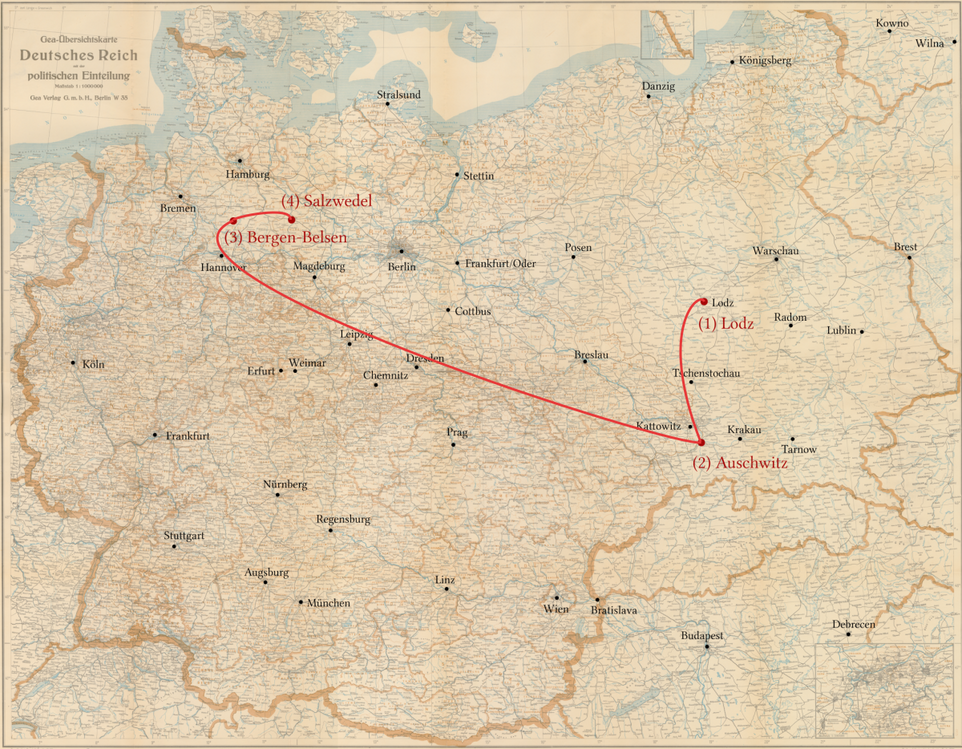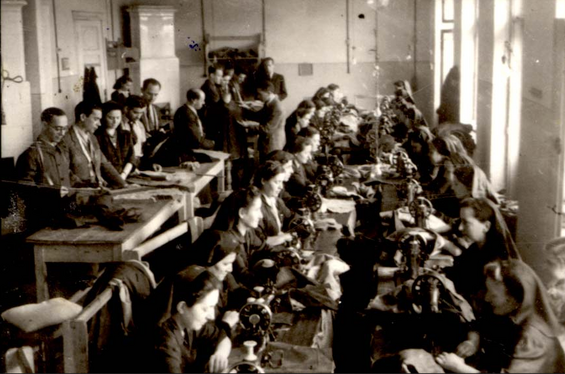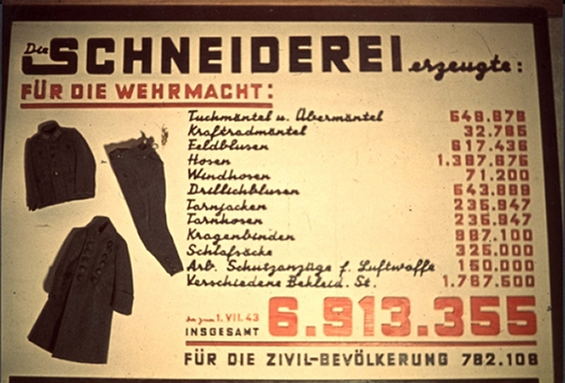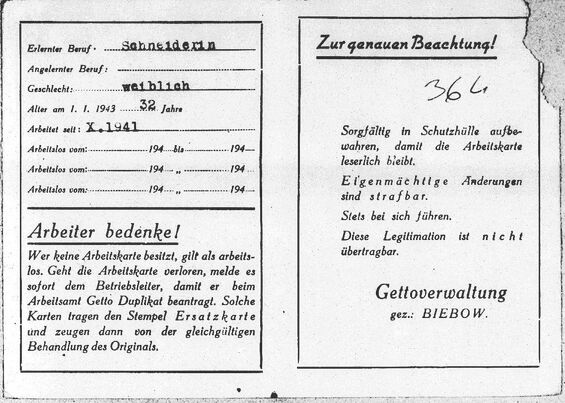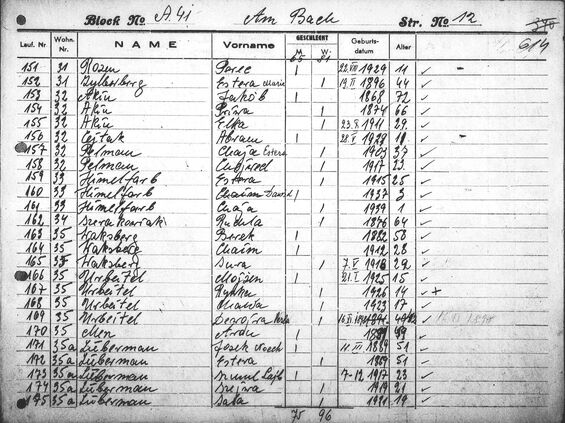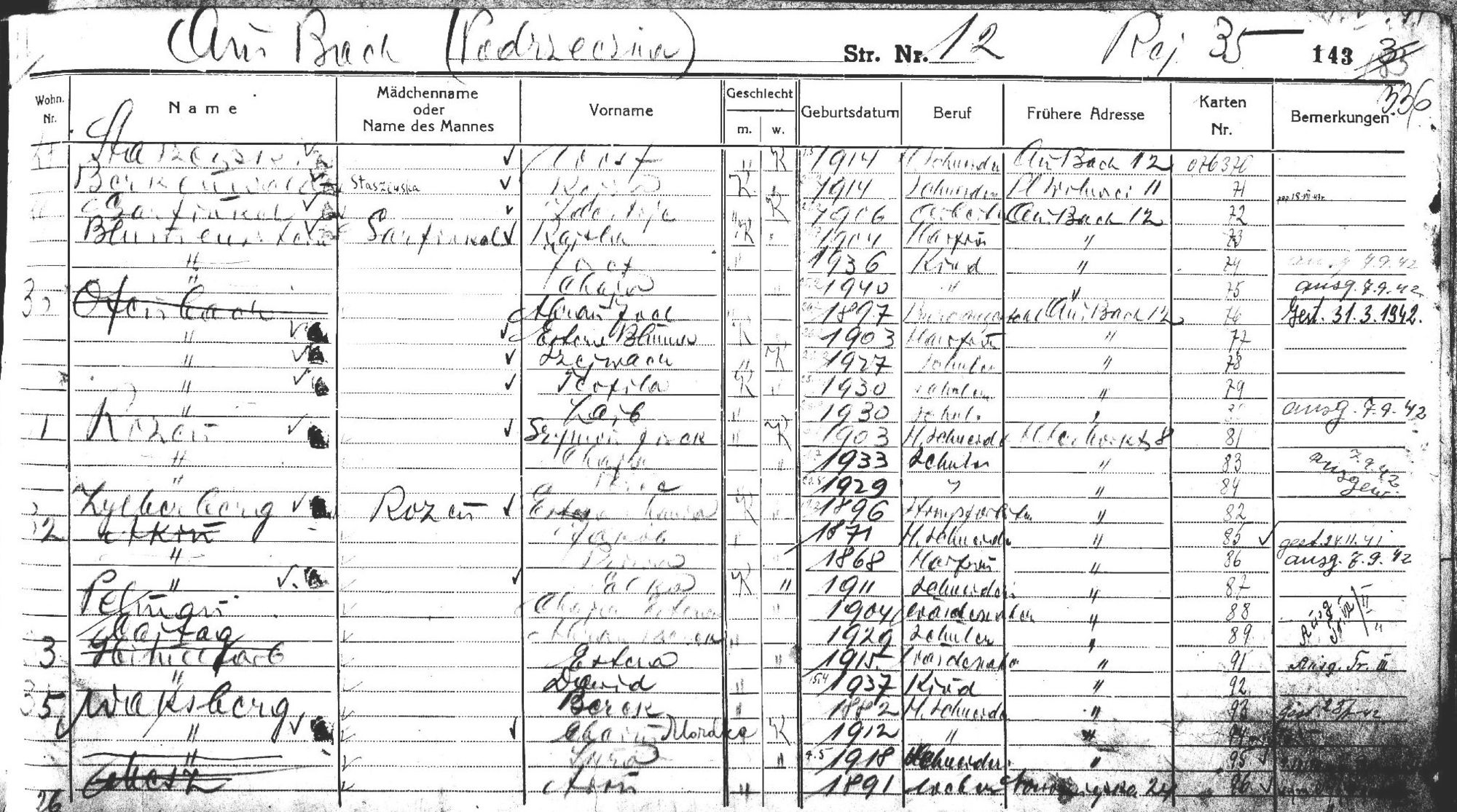The Biography of Elka Kolski, née Akin, Lodz
Short biography and stations of her persecution
- Born 23 Oct. 1911 (1915?) in Lodz as Elka Akin
- May 1940 to July 1944 Lodz ghetto,
- August 1944 Auschwitz concentration camp
- August 1944 Bergen-Belsen concentration camp
- October 1944 or December 1944 Neuengamme concentration camp/Salzwedel subcamp
- 14 April 1945 liberated
- November 1949: Emigration to the USA
Elka Kolski lost her parents and four brothers in the Holocaust. She was 30 years old when her persecution began.
Note: The date "1915" is given in the affidavit, "1911" in the documents from the Lodz ghetto. However, the names of the parents and the occupation match the information in the affidavit, see list of residents "Am Bach 12"'
Before the war and start of the persecution
I am making this affidavit in connection with my application for compensation for physical injury and damage to health. Before World War II, I lived with my parents and siblings in Lodz, Poland. I was a happy, healthy girl and had no physical complaints whatsoever. After completing elementary school, I learned the tailoring trade from my father and later worked in my parents' business, a men's tailor shop. I had a sufficient income and no worries. In 1938, I got engaged and we planned to marry soon. All this changed when World War II broke out and Lodz was occupied by the Nazis. Shortly afterwards, everything we owned was taken away from us. At that time, I did not have to work yet.
Source: Unless otherwise stated: Konrad Kittl files, affidavit by Elka Kolski;
May 1940 to July 1944 Lodz ghetto
I, the undersigned Elka Kolski, née Akin, born on 23 October 1915 in Lodz (Poland) hereby declare on oath that I was living there on 1 October 1939 when Lodz was occupied by the Germans. In the same month we had to wear the Jewish star and from then on we had to be aware at all times that I would be called in for forced labour.
On 1 May, the already existing ghetto was completely sealed off. The ghetto was surrounded by barbed wire and there were only heavily guarded exits. I had to do forced labour in the ghetto, working in the department where uniforms for the SS were made. We had to work at least 10 hours a day, 6 days a week.
Source: Elka Kolski, affidavit. 1956, State Archives of Lower Saxony, Nds. 110 W Acc. 14/99 No. 115972
But later on, when we were taken to the ghetto, I was forced to work 12 hours a day in a tailor's shop. I soon emaciated to a skeleton because we didn't get enough food. I suffered greatly from the cold and the unhygienic conditions. My health deteriorated rapidly. Something had gone wrong with my bones due to the inadequate food. A doctor, who was also imprisoned in the ghetto, told me that I needed calcium and that I had to give up my bread for this calcium.
Later, the deportations in the ghetto also began. My parents and four brothers were dragged away and I never saw them again. I myself trembled every day at the prospect of being dragged off to the gas chambers. I was brutally beaten twice in the ghetto. One day I was queuing for potatoes - the ration had been cut off for 10 days - and was beaten up by guards for no reason at all until I lay unconscious. Friends then dragged me away. Some time later, when I didn't work fast enough, I was abused again. Various epidemics broke out in the ghetto. I didn't contract typhus, but I suffered from constant dysentery.
Note: The father Jakob/Jankiel, the mother Priwa and Elka Akin had to move into the house "Am Bachstr. 12" with 230 other residents, see USHMM document "Block No. A 41 Am Bach Str. No.12 (ID: 36289)". In a later document "Am Bach (Podrzeczna) Str. No. 12 (ID: 36729)", the father is noted as "gest. 28.11.41" and the mother as "ausg. 7.9.42". According to the explanation of the document, "ausg. Date" means the deportation to Chelmno on the date given, "gest." means died. At this time, the list comprised 275 persons.
Auschwitz
When the ghetto was liquidated, I was dragged to Auschwitz. I only stayed in Auschwitz for a short time. I didn't have to work there. But it was terrible. I was once beaten up when I went to get coffee. An SS woman said I didn't need coffee and knocked it out of my hand and abused me. Another time, when I wanted to go to a toilet, two SS women beat me up. I thought I wouldn't get out of Auschwitz alive.
cAugust/September 1944 to Oktober/December 1944 Bergen-Belsen
I was transported from Auschwitz to Bergen Belsen. We were locked in a cattle wagon and were given nothing to eat for the entire journey. I saw so many people die during that time that I still think about it with horror today. Again, I didn't work in Bergen Belsen itself. We had to do cleaning work from time to time. It was unspeakably dirty there. We had to sleep in wooden barracks on the floor, which was only covered with dirty wood wool.
Oktober/Dezember 1944 bis 14.4.1945 Salzwedel
In August 1944 I was sent to Auschwitz-Birkenau, but I only stayed there for 2 weeks, so I didn't get a number branded on my body. From there I was sent to Bergen-Belsen where I stayed for about 7 weeks, then I was sent on to Salzwedel where I stayed until mid-April 1945, when I was liberated. In Salzwedel I was in a forced labour camp with maybe 3000 other women. We had to work in the munitions factory. We had to work at least 10 hours a day, 6 days a week. I don't remember what number I had to wear.
Source: Elka Kolski, affidavit. 1956, State Archives of Lower Saxony, Nds. 110 W Acc. 14/99 No. 115972
After a while, I was dragged to Salzwedel, where I had to work in an ammunition factory, making shell casings for cartridges on a machine. I had to work more than 12 hours a day. The conditions there were also very bad. I was more dead than alive when I was liberated.
| Subcamp of the Neuengamme concentration camp number !998 | |
|---|---|
| Location | Salzwedel |
| Name | |
| Area | Province of Saxony |
| Opening | 10 July 1944 |
| Closing | 15 April 1945; in April 1945: "evacuation" of some of the prisoners to the Wöbbelin satellite camp; liberation on 14/15 April 1945 [LIT] |
| Deportations | In July 1944, a transport of 1,500 women arrived from Ravensbrück concentration camp. [LIT] |
| Prisons | On 25 March 1945: 1,518 |
| Gender | Women |
| Employment of the prisoners at | Munitions factory |
| Type of work | Mine production |
| Source: deutschland-ein-denkmal.de | |
Nach der Befreiung
After my liberation, I stayed in West Germany until 1949 and emigrated to the USA in November 1949. I have lived in Pittsburgh ever since.
Notes
Office for Compensation
Hannover, EB-II/R 1 115972-K-, 1964-1967
Notes
Elka Kolski gave an interview to the USC Shoah Foundation in 1995.
Picture Credits
- Yad Vashem Archival signature 1602/346, Credit: Yad Vashem
- Jüdisches Museum Frankfurt am Main, Lodz-A335, Foto: Walter Genewein (siehe Yad Vashem 3435/335)
- United States Holocaust Memorial Museum; name list 27047: Documents related to the identification and registration of Jewish workers, including worker cards
- United States Holocaust Memorial Museum; name list 27047: Documents related to the identification and registration of Jewish workers, including worker cards
- United States Holocaust Memorial Museum; name list 36289: Block Number A 41, Am Bach Street Number 12, vom 16. 6. 1940
- United States Holocaust Memorial Museum; Block No. name list ID: 36729: Am Bach (Podrzeczua) Str. Nr. 12, ohne Datumsangabe
